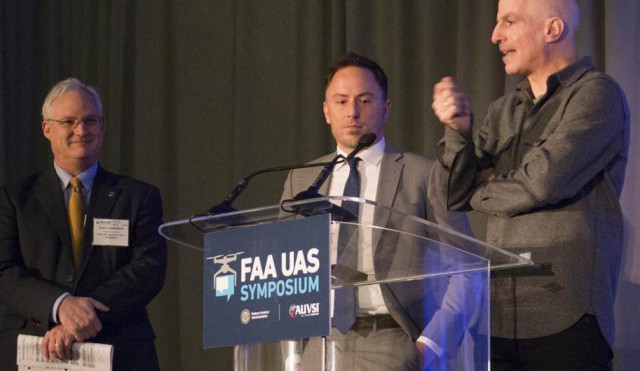“The message of this whole conference is, the FAA is open for business,” said Derek Kan, undersecretary for policy at the U.S. Department of Transportation, summing up the Federal Aviation Administration’s stance at the third annual FAA UAS Symposium, cosponsored by AUVSI.
FAA official said repeatedly that they want to talk to industry about ways to help companies achieve their goals, including for beyond-line-of-sight flights and package delivery.
One key element to achieve such things is an unmanned traffic management system, which NASA is working on, along with numerous industry and government partners.
“Our research will be completed by 2019,” said Parimal Kopardekar, who is leading the UTM effort for NASA.
NASA’s work is divided into modular sections, so some functions can be rolled out before the whole effort is finished and turned over to industry to implement.
“Our hope is not to wait for all of it to be finished before implementing things,” Kopardekar said.
Jay Merkel, a deputy vice president at the FAA’s Air Traffic Organization, urged attendees, “don’t wait for UTM. We are all here ready to start moving you toward whatever you need under this paradigm. You just need to help us understand what you need and where you need it and we will help you get there.”
Amazon and Google
Two online giants, Amazon and Google, have outlined how they believe their planned package delivery systems will work.
Gur Kimchi, vice president of Amazon Prime Air, says UAS communications will be a series of “federated” systems, much like cell phone networks, not one overarching system.
“There is no center, there is no one place that everybody talks to to get authorization,” he said.
Future UAS networks will need to match the safety of the existing manned aviation system, he said, which can be done by authenticating who is operating a given drone and allowing vehicle-to-vehicle communications and automated controllers.
When a drone is to cross a boundary with another aircraft, it would have to notify that aircraft, and would also talk to its automated controller, which would automatically deconflict the two.
To make this work, Kimchi said the industry needs protocols for controller-to-controller communication, which are being developed right now; protocols for vehicle-to-vehicle communications, which could be a safety fallback if the internet is blocked or slow; and performance-based rules and regulations for automated aircraft sense and avoid.
“The airspace is shared. When you are in the airspace, you must share information with everyone else in the airspace to stay safe,” he said. “It’s not a private network, it’s just not like other domains.”
James Burgess of Project Wing, the delivery program for X, formerly Google X, said his effort is taking a risk-based approach to test its hardware and software.
He agreed with Kimchi that “automation is very necessary for these systems,” and their testing has shown that more automation makes the system safer. He also agreed in the concept of federated control systems, “so multiple providers can offer this service in a way that’s safe and scalable.”
Project Wing has racked up more than 850 delivery test flights, which included learning about the fears of residents who were local to where the tests took place. For instance, in a rural area, they had to demonstrate that drone flights wouldn’t scare horses.
Risk-based flight approvals are “a trend we already seen, and we’re really excited by,” he said.
For instance, Project Wing drones fly with an LTE link. If that is lost, the traditional thinking is that the drone should land. That might not actually be the best idea, he said. If the route has no conflicts with other aircraft, “maybe it’s safer to keep flying and finish the mission.”
Earl Lawrence, executive director of the FAA UAS Integration Office, said the FAA agrees with the general approach from Amazon and Google.
“I’m sitting there thinking we’re all starting to speak the same language,” he said. “We are innovating together.”
Photo: AUVSI
Source: AUVSI

